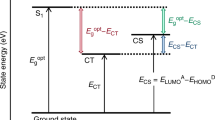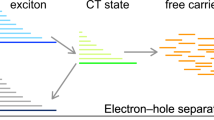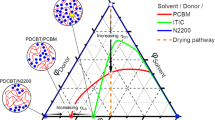Abstract
The increasing amount of research on solution-processable, organic donor–acceptor bulk heterojunction photovoltaic systems, based on blends of conjugated polymers and fullerenes has resulted in devices with an overall power-conversion efficiency of 6%. For the best devices, absorbed photon-to-electron quantum efficiencies approaching 100% have been shown. Besides the produced current, the overall efficiency depends critically on the generated photovoltage. Therefore, understanding and optimization of the open-circuit voltage (Voc) of organic solar cells is of high importance. Here, we demonstrate that charge-transfer absorption and emission are shown to be related to each other and Voc in accordance with the assumptions of the detailed balance and quasi-equilibrium theory. We underline the importance of the weak ground-state interaction between the polymer and the fullerene and we confirm that Voc is determined by the formation of these states. Our work further suggests alternative pathways to improve Voc of donor–acceptor devices.
This is a preview of subscription content, access via your institution
Access options
Subscribe to this journal
Receive 12 print issues and online access
$259.00 per year
only $21.58 per issue
Buy this article
- Purchase on Springer Link
- Instant access to full article PDF
Prices may be subject to local taxes which are calculated during checkout





Similar content being viewed by others
References
Thompson, B. C. & Fréchet, J. M. J. Polymer-fullerene composite solar cells. Angew. Chem. Int. Ed. 47, 58–77 (2008).
Park, S. H. et al. Bulk heterojunction solar cells with internal quantum efficiency approaching 100%. Nature Photon. 3, 297–302 (2009).
Dennler, G., Scharber, M. C. & Brabec, C. J. Polymer-fullerene bulk-heterojunction solar cells. Adv. Mater. 13, 1323–1338 (2009).
Scharber, M. C. et al. Design rules for donors in bulk-heterojunction solar cells—towards 10% energy-conversion efficiency. Adv. Mater. 18, 789–794 (2006).
Veldman, D., Meskers, S. C. J. & Janssen, R. A. J. The energy of charge-transfer states in electron donor–acceptor blends: Insight into the energy losses in organic solar cells. Adv. Funct. Mater. 19, 1939–1948 (2009).
Shockley, W. & Queisser, H. Detailed balance limit of efficiency of p–n junction solar cells. J. Appl. Phys. 32, 510–519 (1961).
Gadisa, A., Svensson, M., Andersson, M. R. & Inganäs, O. Correlation between oxidation potential and open-circuit voltage of composite solar cells based on blends of polythiophenes/fullerene derivative. Appl. Phys. Lett. 84, 1609–1611 (2004).
Nelson, J., Kirkpatrick, J. & Ravirajan, P. Factors limiting the efficiency of molecular photovoltaic devices. Phys. Rev. B 69, 035337 (2004).
Rand, B. P., Burk, D. P. & Forrest, S. R. Offset energies at organic semiconductor heterojunctions and their influence on the open-circuit voltage of thin-film solar cells. Phys. Rev. B 75, 115327 (2007).
Potscavage, W. J., Yoo, S. & Kippelen, B. Origin of the open-circuit voltage in multilayer heterojunction organic solar cells. Appl. Phys. Lett. 93, 193308 (2008).
Kirchartz, T., Mattheis, J. & Rau, U. Detailed balance theory of excitonic and bulk heterojunction solar cells. Phys. Rev. B 78, 235320 (2008).
Benson-Smith, J. J. et al. Formation of a ground-state charge-transfer complex in polyfluorene/[6,6]-phenyl-C-61 butyric acid methyl ester (PCBM) blend films and its role in the function of polymer/PCBM solar cells. Adv. Funct. Mater. 17, 451–457 (2007).
Loi, M. A. et al. Charge transfer excitons in bulk heterojunctions of a polyfluorene copolymer and a fullerene derivative. Adv. Funct. Mater. 17, 2111–2116 (2007).
Hallermann, M., Haneder, S. & Da Como, E. Charge-transfer states in conjugated polymer/fullerene blends: Below-gap weakly bound excitons for polymer photovoltaics. Appl. Phys. Lett. 93, 053307 (2008).
Veldman, D. et al. Compositional and electric field dependence of the dissociation of charge transfer excitons in alternating polyfluorene copolymer/fullerene blends. J. Am. Chem. Soc. 130, 7721–7735 (2008).
Kim, H. et al. Electroluminescence in polymer-fullerene photovoltaic cells. Appl. Phys. Lett. 86, 183502 (2005).
Tvingstedt, K. et al. Electroluminescence from charge transfer states in polymer solar cells. J. Am. Chem. Soc. 131, 11819–11824 (2009).
Goris, L. et al. Absorption phenomena in organic thin films for solar cell applications investigated by photothermal deflection spectroscopy. J. Mater. Sci. 40, 1413–1418 (2005).
Goris, L. et al. Observation of the subgap optical absorption in polymer-fullerene blend solar cells. Appl. Phys. Lett. 88, 052113 (2006).
Vandewal, K. et al. The relation between open-circuit voltage and the onset of photocurrent generation by charge-transfer absorption in polymer: fullerene bulk heterojunction solar cells. Adv. Funct. Mater. 18, 2064–2070 (2008).
Campoy-Quiles, M. et al. Morphology evolution via self-organization and lateral and vertical diffusion in polymer: fullerene solar cell blends. Nature Mater. 7, 158–164 (2008).
Ma, W. L., Yang, C. Y., Gong, X., Lee, K. & Heeger, A. J. Thermally stable, efficient polymer solar cells with nanoscale control of the interpenetrating network morphology. Adv. Funct. Mater. 15, 1617–1622 (2005).
Peet, J. et al. Efficiency enhancement in low-bandgap polymer solar cells by processing with alkane dithiols. Nature Mater. 6, 497–500 (2007).
Wienk, M. M. et al. Efficient methano[70]fullerene/MDMO-PPV bulk heterojunction photovoltaic cells. Angew. Chem. Int. Ed. 42, 3371–3375 (2003).
Vanecek, M. & Poruba, A. Fourier-transform photocurrent spectroscopy of microcrystalline silicon for solar cells. Appl. Phys. Lett. 80, 719–721 (2002).
Würfel, P. The chemical potential of radiation. J. Phys. C 15, 3967–3985 (1982).
Schick, K., Daub, E., Finkbeiner, S. & Würfel, P. Verification of a generalized Planck law for luminescence radiation from silicon solar cells. Appl. Phys. A 54, 109–114 (1992).
Trupke, T., Würfel, P., Uhlendorf, I. & Lauermann, I. Electroluminescence of the dye-sensitized solar cell. J. Phys. Chem. B 103, 1905–1910 (1999).
Band, Y. B. & Heller, D. F. Relationships between absorption and emission of light in multilevel systems. Phys. Rev. A 38, 1885–1895 (1988).
Ross, R. T. & Calvin, M. Thermodynamics of light emission and free-energy storage in photosynthesis. Biophys. J. 7, 595–614 (1967).
Green, M. A. Third Generation Photovoltaics: Advanced Solar Energy Conversion (Springer, 2006).
Rau, U. Reciprocity relation between photovoltaic quantum efficiency and electroluminescent emission of solar cells. Phys. Rev. B 76, 085303 (2007).
Kirchartz, T. & Rau, U. Detailed balance and reciprocity in solar cells. Phys. Status Solidi A 205, 2737–2751 (2008).
Bruan, D. Electron injection and conduction processes for polymer devices. J. Polym. Sci. Part B: Polym. Phys. 41, 2622–2629 (2003).
Waldauf, C., Scharber, M. C., Schilinsky, P., Hauch, J. A. & Brabec, C. J. Physics of organic bulk heterojunction devices for photovoltaic applications. J. Appl. Phys. 99, 104503 (2006).
Panda, P. et al. Charge transfer absorption for pi-conjugated polymers and oligomers mixed with electron acceptors. J. Phys. Chem. B 111, 5076–5081 (2007).
Foster, R. Organic Charge-Transfer Complexes (Academic, 1969).
Pope, M. & Swenberg, C. E. Electronic Processes in Organic Crystals and Polymers (Oxford Univ. Press, 1999).
Ross, R. B. et al. Endohedral fullerenes for organic photovoltaic devices. Nature Mater. 8, 208–212 (2009).
Lenes, M. et al. Fullerene bisadducts for enhanced open-circuit voltages and efficiencies in polymer solar cells. Adv. Mater 20, 2116–2119 (2008).
Zhang, F. et al. High photovoltage achieved in low band gap polymer solar cells by adjusting energy levels of a polymer with the LUMOs of fullerene derivatives. J. Mater. Chem. 18, 5468–5474 (2008).
Perez, M. D., Borek, C., Forrest, S. R. & Thompson, M. E. Molecular and morphological influences on the open circuit voltages of organic photovoltaic devices. J. Am. Chem. Soc. 131, 9281 (2009).
Acknowledgements
K.V., A.G. and J.V.M. acknowledge the institute for the promotion of science and technology in Flanders (IWT-Vlaanderen) the IWT-project polyspec, the FWO project nano-fibres and the European project solar-n-type. K.T. and O.I. thank the Swedish Energy Agency for funding through the programme Tandem. All authors acknowledge M.R. Andersson at Chalmers University for supplying APFO3 and LBPP5 and Markus Scharber for supplying PCPDTBT. D. Vanderzande, W. D. Oosterbaan, P. Adriaensens and S. Chambon are thanked for valuable discussions.
Author information
Authors and Affiliations
Contributions
K.V. and A.G. prepared the devices and carried out FTPS measurements in Hasselt. K.T. and K.V. prepared devices and carried out the electroluminescence measurements in Linköping. K.V. wrote the paper. All authors provided comments on the manuscript. J.V.M. and O.I. directed the research.
Corresponding author
Supplementary information
Supplementary Information
Supplementary Information (PDF 745 kb)
Rights and permissions
About this article
Cite this article
Vandewal, K., Tvingstedt, K., Gadisa, A. et al. On the origin of the open-circuit voltage of polymer–fullerene solar cells. Nature Mater 8, 904–909 (2009). https://doi.org/10.1038/nmat2548
Received:
Accepted:
Published:
Issue Date:
DOI: https://doi.org/10.1038/nmat2548
This article is cited by
-
Rational molecular and device design enables organic solar cells approaching 20% efficiency
Nature Communications (2024)
-
High-performance vertical field-effect organic photovoltaics
Nature Communications (2023)
-
Suppressing electron-phonon coupling in organic photovoltaics for high-efficiency power conversion
Nature Communications (2023)
-
Origins of the open-circuit voltage in ternary organic solar cells and design rules for minimized voltage losses
Nature Energy (2023)
-
Understanding what limits the voltage of polycrystalline CdSeTe solar cells
Nature Energy (2022)



